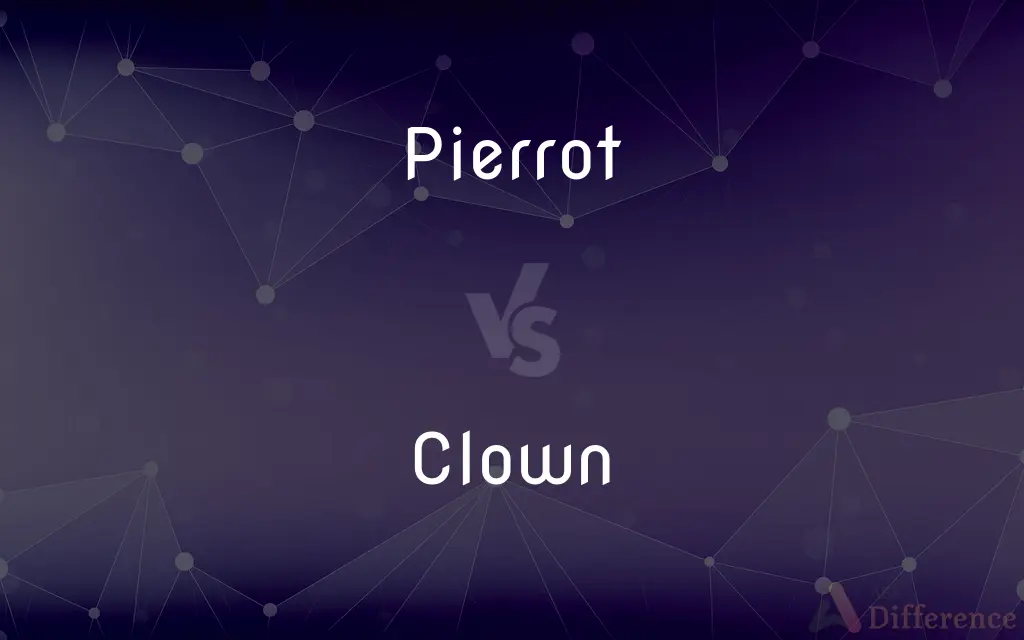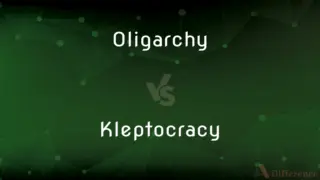Pierrot vs. Clown — What's the Difference?
By Tayyaba Rehman — Updated on November 3, 2023
Pierrot is a pantomime character, typically portraying a sad clown with a white face and loose, white clothing. A clown is a comic performer, characterized by colorful clothes, makeup, and often a red nose, aiming to entertain with physical comedy.

Difference Between Pierrot and Clown
Table of Contents
ADVERTISEMENT
Key Differences
Pierrot is a classic figure in pantomime and Commedia dell'arte, characterized by his white, billowy costume and a face painted white, reflecting a sad, pining lover. The Clown, on the other hand, is a broader term that encompasses a wide range of comic performers, whose primary purpose is to entertain and evoke laughter with outlandish costumes, makeup, and slapstick humor.
The persona of Pierrot originated in late seventeenth-century France, becoming a stock character who is innocent and naïve, often the butt of jokes but with a bittersweet vulnerability. Clowns have been a part of many cultures for centuries, evolving from jesters and court entertainers to the modern circus clown, known for their physical comedy and playful antics.
While Pierrot is associated with mime and silent expression, conveying emotion through gesture and posture, the Clown is usually associated with loud and boisterous behavior, engaging in verbal humor, pratfalls, and acrobatic stunts to entertain a diverse audience.
The aesthetic of Pierrot is distinctive, with white-powdered skin, subtle makeup, and sometimes a single tear to symbolize his melancholy, while Clowns have exaggerated features, with brightly painted faces, red noses, and colorful wigs, designed to capture attention and exaggerate expressions.
The narrative role of Pierrot is often as a reflective, soulful character caught in unrequited love or existential crises, while the Clown's role is to disrupt normality, challenge social norms, and provoke laughter through shock, surprise, or sheer silliness.
ADVERTISEMENT
Comparison Chart
Origin
17th-century French pantomime
Diverse origins, including ancient plays and royal courts
Costume
White, loose-fitting clothing
Colorful outfits, often with a patterned design
Facial Makeup
White face, subtle makeup
Brightly colored face, exaggerated features
Character Traits
Melancholic, moonstruck lover
Joyful, joker, physical comedian
Performance Style
Mime, silent expression, pantomime
Verbal humor, slapstick, acrobatics
Compare with Definitions
Pierrot
Pierrot is a traditional mime character often expressing sadness.
The actor's portrayal of Pierrot, with his silent tears, captivated the audience.
Clown
A clown can be a comedic character in a play or skit.
The clown's slapstick humor brought a light-heartedness to the otherwise serious play.
Pierrot
Pierrot often represents the archetype of the sad clown in literature and art.
The painting depicted Pierrot alone in the moonlight, a symbol of unrequited love.
Clown
A clown is a performer who uses exaggerated actions to entertain.
The clown's antics had the children laughing uproariously.
Pierrot
Pierrot is known for his white, billowy costume and plaintive love.
The stage was set for a classic love story as Pierrot pined for his beloved Columbine.
Clown
A clown is often associated with the circus and wears colorful makeup.
Brightly dressed and full of energy, the clown juggled with ease.
Pierrot
Pierrot is a figure of innocence and is often portrayed as a fool.
Despite his foolishness, Pierrot elicited sympathy rather than ridicule.
Clown
A clown is a person who wears a unique makeup-face and flamboyant costume, performing comedy in a state of open-mindedness (by reversing folkway-norms) all while using physical comedy.
Pierrot
Pierrot is a mime character who communicates through expressive movement.
Pierrot's silent mime spoke louder than words, conveying a spectrum of emotions.
Clown
A comic entertainer, especially one in a circus, wearing a traditional costume and exaggerated make-up
A circus clown
Pierrot
Pierrot ( PEER-oh, US also PEE-ə-roh, PEE-ə-ROH, French: [pjɛʁo] (listen)) is a stock character of pantomime and commedia dell'arte whose origins are in the late seventeenth-century Italian troupe of players performing in Paris and known as the Comédie-Italienne; the name is a diminutive of Pierre (Peter), via the suffix -ot. His character in contemporary popular culture—in poetry, fiction, and the visual arts, as well as works for the stage, screen, and concert hall—is that of the sad clown, often pining for love of Columbine, who usually breaks his heart and leaves him for Harlequin.
Clown
An unsophisticated country person; a rustic.
Pierrot
A character in French pantomime, dressed in a floppy white outfit.
Clown
Behave in a comical or playful way
Harvey clowned around pretending to be a dog
Pierrot
Alternative form of Pierrot
Clown
A buffoon or jester who entertains by jokes, antics, and tricks in a circus, play, or other presentation.
Pierrot
Any of various lycaenid butterflies of the genera Tarucus and Castalia, notable for white contrasting with brown or black on the underwings.
Clown
One who jokes and plays tricks.
Pierrot
(historical) An 18th-century women's low-cut basque with sleeves.
Clown
A coarse, rude, vulgar person; a boor.
Pierrot
A male character in French pantomime; usually dressed in white with a whitened face
Clown
A peasant; a rustic.
Clown
To behave like a buffoon or jester.
Clown
To perform as a buffoon or jester.
Clown
To krump, especially in clown makeup.
Clown
A slapstick performance artist often associated with a circus and usually characterized by bright, oversized clothing, a red nose, face paint, and a brightly colored wig.
Clown
A person who acts in a silly fashion.
He was regarded as the clown of the school, always playing pranks.
Clown
A stupid or badly-behaved person.
Clown
(obsolete) A man of coarse nature and manners; an awkward fellow; an illbred person; a boor.
Clown
(obsolete) One who works upon the soil; a rustic; a churl; a yokel.
Clown
A clownfish.
Clown
To act in a silly or playful fashion.
Clown
To ridicule.
Clown
A man of coarse nature and manners; an awkward fellow; an ill-bred person; a boor.
Clown
One who works upon the soil; a rustic; a churl.
The clown, the child of nature, without guile.
Clown
The fool or buffoon in a play, circus, etc.
The clown shall make those laugh whose lungs are tickle o'the sere.
Clown
To act as a clown; - with it.
Beshrew me, he clowns it properly indeed.
Clown
A rude or vulgar fool
Clown
A person who amuses others by ridiculous behavior
Clown
Act as or like a clown
Clown
A clown often performs stunts or tricks to amuse an audience.
The clown flipped and tumbled, captivating the crowd with his acrobatics.
Clown
A clown is also a term used to describe a foolish or playful person.
Stop being such a clown and take this seriously for once!
Common Curiosities
What type of performance is associated with Pierrot?
Pierrot is most associated with silent mime and pantomime.
What does the word "Pierrot" mean?
It refers to a character in French pantomime, a sad and lovelorn clown.
How did the character of Pierrot originate?
Pierrot originated in the 17th century in the Commedia dell'arte tradition.
Are clowns always part of a circus?
No, clowns can be part of various entertainment forms, including theater, television, and parties.
What's the difference between Pierrot and a mime?
Pierrot is a specific character within mime, known for his sad demeanor, while mime is the broader art form of silent performance.
Is a Pierrot always sad?
Traditionally, Pierrot is depicted as melancholic or pining, often in unrequited love.
What is the traditional costume of a Pierrot?
It includes white, loose-fitting clothes with a white face painted to express sadness.
Are Pierrots and clowns found in cultures outside of France and Europe?
Yes, variations of the sad clown and comic clown are found worldwide.
What is the role of a clown?
A clown's role is to entertain by being funny, often through physical comedy and exaggerated behavior.
Can the term "clown" refer to non-performers?
Yes, it can colloquially refer to someone who behaves in a silly or foolish manner.
What kind of makeup does a clown wear?
A clown wears bright, exaggerated makeup, often with a red nose and colorful wig.
Have Pierrots and clowns evolved over time?
Yes, both have seen changes in their portrayal and cultural significance throughout history.
Do clowns always make people laugh?
While intended to be funny, clowns can sometimes evoke different emotions depending on the audience's perception.
Is a Pierrot ever part of a circus act?
While less common, a Pierrot-inspired character can be part of a modern circus.
Can Pierrot and clown performances be non-verbal?
Yes, both can perform non-verbally, though it is more characteristic of Pierrot to do so.
Share Your Discovery

Previous Comparison
Silica vs. Silicate
Next Comparison
Oligarchy vs. KleptocracyAuthor Spotlight
Written by
Tayyaba RehmanTayyaba Rehman is a distinguished writer, currently serving as a primary contributor to askdifference.com. As a researcher in semantics and etymology, Tayyaba's passion for the complexity of languages and their distinctions has found a perfect home on the platform. Tayyaba delves into the intricacies of language, distinguishing between commonly confused words and phrases, thereby providing clarity for readers worldwide.
















































